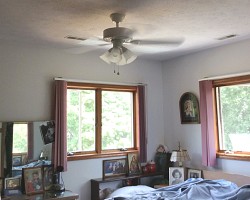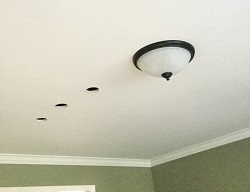Knob and Tube Replacement Cost
If you're living in an older home or looking at one to buy, you may have encountered the term "knob and tube wiring," usually in the form of a recommendation to replace it for safety reasons. What exactly is knob and tube wiring, why should it be replaced, and, critically, how much is it going to cost you? Overall, the benefits vastly outweigh knob and tube replacement cost, making it a smart decision for homeowners.
Knob and Tube Wiring
This type of wiring started to be used in the late 1800s, continuing into the early 20th century. It consists of two long wires covered in rubber insulators and run along the beams of a house, wrapped around ceramic tubes at the joists and at key joins to prevent chafing (which could damage the insulator and create an electrical problem). Material called loom covers the insulation at key points to add protection.
You don't want knob and tube wiring in your house for a number of reasons. For one thing, from a purely legal perspective, it's usually a violation of the electrical code. Having knob and tube wiring can cause problems with home sales, insurance paperwork, and other activities related to your home. Insurers may balk at providing coverage for a home with knob and tube wiring unless the insulation is in good condition, which usually isn't the case.
The reason this type of wiring contravenes electrical code in most cases is because it's unsafe. The wiring is ungrounded, and in older homes, it usually doesn't have sufficient branch circuits to handle the power demands of modern life. When multiple appliances are run at once, they tend to overload knob and tube wiring and cause a fire. Furthermore, that insulation is often severely damaged, which can lead to spontaneous problems.
While it is generally legal to have knob and tube wiring, it cannot be newly installed, and in some cases may need to be repaired or replaced to bring a home up to code if it's in poor condition.
Rewiring: How Much Will It Cost?
For a standard two-story home, knob and tube replacement cost may run between $4,000 and $8,000, and for every additional story, plan on adding at least $2,000. This includes running new wiring, filling in holes, disconnecting the old system, installing a modernized junction box, replacing fuses with breakers, and updating any necessary outlets, receptacles, and fixtures connected directly to the wiring.
The process is often time-consuming and disruptive, as electricians will need full access to the house for the project, and power will need to be shut off so they can work safely. They'll also be adding more receptacles to update the home to the current electrical code, which mandates more coverage to reduce the risk of electrical overload.
Costs will increase if the home doesn't have good crawlspaces and attic access, making it harder to work. Knob and tube replacement cost can also be higher if you need to install additional electrical panels in locations like the garage, or if you have outbuildings that also require rewiring.
Be aware that knob and tube replacement cost may not factor in the cost of patching holes in the walls, matching paint, and other tasks related to cleaning up after the new electrical installation.
As with any electrical project, find a licensed electrician to do the work, and request multiple quotes to obtain the best rate and service. If you're considering the purchase of a home with knob and tube wiring, you may want to see whether rewiring could be added to the contract as a condition of sale, or if you can receive a discount on the sales price to reflect the expense of redoing the wiring. Some mortgage lenders may refuse a loan or take longer to make a decision out of concern about the risks of knob and tube wiring.
Katie Marks writes for Networx.com.
Updated January 17, 2018.
Looking for a Pro? Call us (866) 441-6648

Electrical Average Costs
Electricians Experiences

Parking Lot Lights Restored So Employees Can Reach Cars Safely

Ceiling Fan Replacement By A Fast, Knowledgeable And Reasonable Electrician



